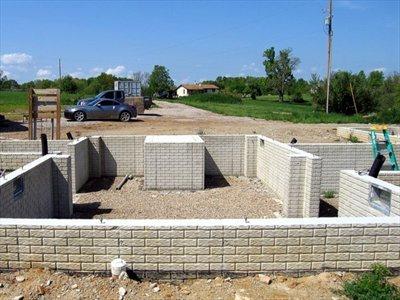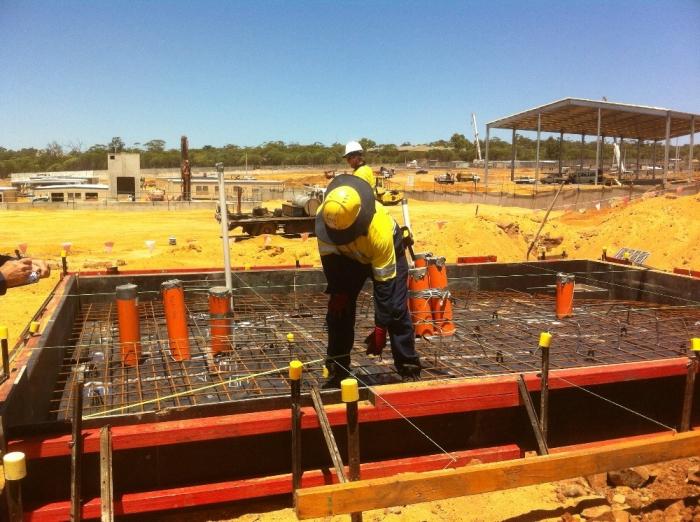The main task of the foundation is to transfer the load from the structure to the soil. Therefore, the collection of loads on the foundation - one of the most important tasks that must be solved even before the construction of the building.
What to consider when calculating the load
The correctness of the calculation is one of the keysteps in construction that needs to be solved. When carrying out incorrect calculations, most likely, under the pressure of loads, the foundation will simply settle and “go underground”. When calculating and collecting the loads on the foundation, it is necessary to take into account that there are two categories - temporary and permanent loads.
- The first is, of course, the weight itself.the building itself. The total weight of the structure consists of several components. The first component is the total weight of the building’s floor slabs for the floor, roof, interfloor, etc. The second component is the weight of all its walls, both load-bearing and internal. The third component is the weight of communications that are laid inside the house (sewage, heating, plumbing). The fourth and last component is the weight of the finishing elements of the house.
- Also, when collecting loads on the foundation, you need to consider the weight, which is called the payload of the building. This paragraph refers to the entire internal structure (furniture, appliances, residents, etc.) at home.
- The third type of load is temporary, which is most often attributed to additional loads due to weather conditions. These include a layer of snow, loads with a strong wind, etc.

An example of the collection of loads on the foundation
In order to accurately calculate all loads,which will fall on the foundation, it is necessary to have an exact plan for the design of the building, as well as to know what materials the building will be built from. In order to more clearly describe the process of collecting loads on the foundation, we will consider the option of building a house with habitable mansandra, which will be located in the Ural region of the Russian Federation.
- One-storey house with habitable mansandra.
- The size of the house will be 10 by 10 meters.
- The height between the ceiling (floor and ceiling) will be 2.5 meters.
- Exterior walls for the house will be erected from aerated concrete blocks, which are 38 cm thick. Also, from the outside of the building, these blocks will be covered with 12 cm thick hollow bricks.
- Inside the house there will be one bearing wall, the width of which will be 38 cm.
- Above the basement of the house there will be an empty ceiling of reinforced concrete material. From the same material will be equipped and overlap for the attic.
- The roof will be of rafter type, and the roof will be made of corrugated.

Calculation of loads on the foundation
Once you have been collecting loads on the foundation of the house, you can start the calculation.
- The first thing to calculate is the total area of all floors. The size of the house is 10 by 10 meters, which means that the total area will be 100 square meters. m (10 * 10).
- Then you can begin to calculate the total areawalls. This value also includes space for openings for doors and windows. For the first floor, the calculation formula will look like this - 2.5 * 4 * 10 = 100 square meters. m. Since the house is inhabited mansandra, then the collection of loads on the foundation, taking into account this building. For this floor area will be equal to 65 square meters. After the calculations, both quantities add up and it turns out that the total area of the walls for the structure is 165 square meters. m
- Next, you need to calculate the total area for the roof of the building. It will be 130 square meters. m. - 1.3 * 10 * 10.
После проведения этих расчетов необходимо use the table of the collection of loads on the foundation, which presents the average values for the materials that will be used during the construction of the building.

Strip foundation
Так как существует несколько типов фундамента, which can be used in the construction of the facility, several options will be considered. The first option is to collect loads on the tape foundation. The list of loads will include the mass of all elements used in the construction of the building.
- Mass walls external and internal. Calculates the total area excluding openings for windows and doors.
- The area for floor slabs and materials from which it will be built.
- The area of the ceiling and ceiling.
- The area of the roof truss system and the weight of roofing materials.
- The area of stairs and other internal elements of the house, as well as the weight of the material from which they will be made.
- You also need to add the weight of materials thatused for fasteners in construction, for arranging the basement, thermal and air insulation, as well as for facing the internal and / or external walls of the house.
These few points are an example of the collection of loads on the foundation for any building that will be erected on a belt-type support.

Calculation methods for strip foundations
You can calculate the strip footingtwo ways. The first method involves the calculation of the bearing capacity of the soil under the base of the foundation, and the second - the deformation of the same soil. Since it is recommended to use the first method for calculations, it will be considered. Everyone knows that direct construction begins with the foundation, but the design of this site is carried out last. This is due to the fact that the main purpose of this design is to transfer the load from the house to the soil. A collection of loads on the foundation can be carried out only after a detailed plan of the future structure is known. The direct calculation of the foundation can be divided into 3 stages:
- The first stage is the determination of the load on the foundation.
- The second stage is the selection of characteristics for the tape.
- The third stage is the adjustment of parameters depending on the operating conditions.
Foundation under the column
When building houses can be usedcolumns as supports. However, the calculation for this type of supporting structure is rather difficult. The whole complexity of the calculation lies in the fact that it is rather difficult to collect loads on the foundation of the column yourself. To do this, you must have a special building education and certain skills. In order to solve the problem of calculating the load on the column foundation, it is necessary to have the following data:
- The first parameter to consider isfor weather conditions. It is necessary to determine the climatic conditions in the region in which the construction is carried out. In addition, an important parameter will be the type and power of winds, as well as the frequency of the rain and their strength.
- At the second stage, it is necessary to make a geodetic map. It is necessary to take into account the flow of groundwater, their seasonal movement, as well as the type, structure and thickness of underground rocks.
- At the third stage, of course, you need to calculate the load on the columns emanating from the building itself, that is, the weight of the future building.
- On the basis of the previously obtained data, it is necessary to choose the right brand of concrete according to its characteristics, strength and composition.

How to calculate the foundation for the column
When calculating the foundation for the columnimplies the calculation of the load per square centimeter of the area of this foundation. In other words, in order to calculate the necessary foundation for the column, you need to know everything about the building, the ground and the groundwater that flow nearby. It is necessary to collect all this information, systematize it, and on the basis of the obtained results it will be possible to carry out a complete calculation of the load on the foundation for the column. In order to have all the necessary information, you need to do the following:
- You must have a complete building design with all communications that will take place inside the building, as well as know what materials will be used for the construction of the building.
- It is necessary to calculate the total area of one support for the structure.
- It is necessary to collect all the parameters of the building and, on their basis, calculate the pressure that the structure will exert on the column type support.
Base Edge
The edge of the foundation is the upper part of the carrierconcrete structure, which accounts for the main pressure from the structure. There is a certain sequence in which it is necessary to collect loads on the edge of the foundation, as well as their further calculation. In order to determine the load on the edge, it is necessary to have a plan for a typical floor of a building, if it is a multi-storey building, or a typical plan for a basement, if the building has only one floor. In addition, you must have a plan for the longitudinal and transverse sections of the building. For example, in order to calculate the load on the edge of the foundation in a ten-story building, you need to know the following:
- Weight, thickness and height of the brick wall.
- The weight of hollow-core reinforced concrete slabs, which are used as floors, as well as multiply this number by the number of floors.
- The weight of partitions multiplied by the number of floors.
- It is also necessary to add the weight of the roof, the weight of the waterproofing and vapor barrier.

conclusions
As you can see, in order to calculate the load on the foundation of any type, you must have all the data about the building, as well as know a lot of formulas for the calculation.

However, at present this task is somewhatsimplified by the fact that there are electronic calculators that perform all calculations instead of people. But for their proper and productive work, it is necessary to load into the device all information about the building, the material from which it will be erected, etc.









